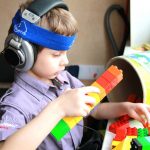Children with attention, sensory, and learning disabilities sometimes experience meltdowns when they are feeling anxiety and sensory overload. These meltdowns can be frustrating for parents, but it’s important to stay positive and take a calm and proactive approach to these emotionally-charged situations.
I’ve found that there are four important things you can do to manage meltdowns effectively and reduce their intensity and frequency over time. One of the therapists I mentored named it, “The Meltdown Recipe”. To set the stage for success with this recipe, start by establishing a safe space your child can visit when they need calmness in their system. Allow the child to access this spot whenever needed and plan for only one adult or caregiver to interact with them during the meltdown.
When a meltdown begins to happen, don’t focus on the specific trigger. Instead, focus on helping your child get to their safe spot as quickly as possible. They may fight this routine at first, as it may raise their anxiety, but over time it should become a reliable and comforting habit.
From there, follow the four steps of The Meltdown Recipe:
1- Don’t get sucked into the meltdown.
First, avoid getting sucked into the meltdown yourself. Of course, this is no easy task when your child is upset, but if you spiral down into having a meltdown too, it will only make matters worse. Try to stay calm and speak in a kind, even tone. Avoid raising your voice or making fast body movements, which could further aggravate the situation.
2- Use simple language.
Now is not the time to share big ideas or theories about why the meltdown is happening. Nor is it time to discuss the situation that triggered it. Your child is in a mode of sensory overload where more input will push them deeper into the meltdown. Keep it simple. Speak in short phrases free from flowery language. Even better, say as little as possible. Use a neutral voice without vocal strain or judgment. The emphasis stays on allowing the body to experience the emotion and raising awareness – a “felt” sense of what it feels like when they are calming down.
Emphasize the importance of going to their safe spot. Again, they may fight this new routine at first due to uncertainty about the consequences, which can cause a rise in their anxiety. Predict this and continue using gentle, simple language to guide them to their safe spot.
3- Don’t solve the problem.
Parents often try to problem-solve their way out of a child’s meltdown. However, if you try to solve this for them, it will only make things worse. Plus, you’re missing a valuable opportunity to help them feel a sense of personal power in this situation. Give them the gift of finding a resolution within themselves.
Don’t tell them it will be okay or otherwise problem-solve their emotions for them. Instead, calmly insist that they enter their safe spot and once they are there, simply request that they remain there until they are “ready.” Do not touch them unless they try to flee their safe spot. Sit near them, but not within the immediate boundaries of their safe spot.
As an adult and as a parent, you may find that during this time you will feel an almost irresistible urge to use logic or reason to help your child calm down. Resist this urge. Allow your child to decide within themselves when they are ready. Give plenty of time for this to happen. It might be immediate or it might take a while.
If you need something to focus on mentally during this difficult period, focus on your own willingness to follow this process consistently, no matter how tedious it is, every single time.
4- Give time in, not time out.
At the point that you and your child feel that their body has calmed down and they are “ready,” re-enter the original situation that triggered the meltdown. Mentally scan the situation and analyze whether the demands on your child were too high or involved too many steps. Continue the situation and don’t allow them to simply avoid the task because of their previous meltdown.
If a sibling or friend is involved, urge your child to say they are sorry and give a reason for being sorry. It doesn’t have to be a logical explanation. Just allow them to put their emotions into words. Continue to accomplish the task that triggered the meltdown and see it through to the end.
Now give them a big hug and tell them you’re proud of them for calming down and completing the task. Feel pride in your own parenting, too. This was a meltdown, but it was also a success!
Please don’t punish your child for having a meltdown. This isn’t bad behavior; it’s sensory overload and your child needs support. It’s important to understand the difference between manipulative behavior and behavior as communication of need.
Later – perhaps during a warm, snuggled-up moment – say that you were disappointed in their behavior at first, but you were proud of them for calming down. Don’t make them feel that they were being “bad,” and instead emphasize that you don’t condone certain behavior and are proud of them for showing other behavior. It’s fine to discuss what might happen again in the future, reviewing the steps of going to their safe spot, calming down, deciding when they’re ready, then trying again.
Tips for managing this process:
I’ve found that many families prefer to begin this process on a weekend when they have no big plans coming up. In fact, if you can start on a weekend and continue into the weekdays with few to no outside obligations, you will accomplish many successful repetitions of “The Meltdown Recipe” and create a positive habit.
Parents often ask me, “But what about when we’re not home?” They’re worried about what to do when their child is away from their safe spot. That’s why it’s best to have practiced this routine many times at home before venturing out into the public to test it.
To learn more about how to handle meltdowns, I invite you to take the Golden Nuggets parent course from The Maude Le Roux Academy. Session 5 explains the “Meltdown Recipe” in more detail and will help you successfully handle these challenging moments in a way that gives your child a sense of empowerment. You can also contact www.atotalapproach.com for a therapist trained in my methodology to assist you further.








